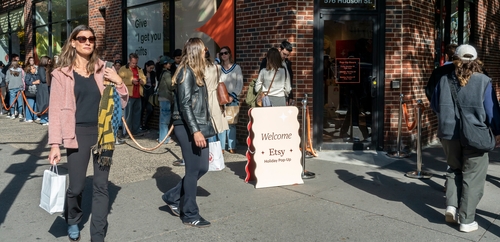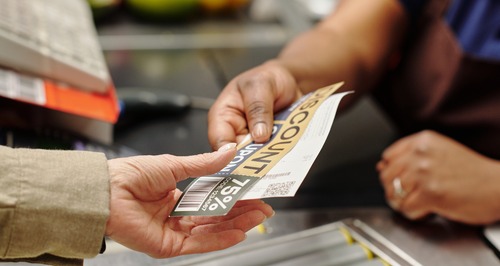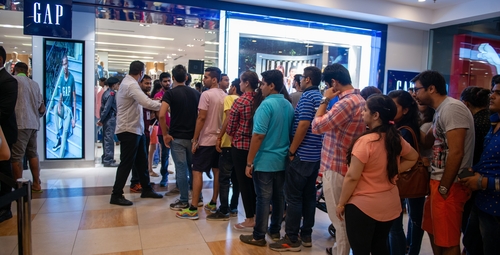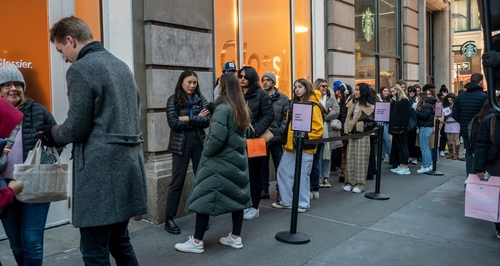28/11/2024
An in-depth look on why we get hooked on discount deals, by Fabian Rivera, Web Project Manager and SEO Expert.
Cyber Monday, the digital cousin of Black Friday, has become a cornerstone of the holiday shopping season, drawing millions of consumers eager for irresistible deals. As online shopping continues to dominate, the psychology of discounts behind consumer behavior during Cyber Monday plays a pivotal role in driving sales. Discounts, mobile accessibility and strategic marketing tactics converge to create a unique shopping experience that capitalizes on human cognitive biases. Understanding the psychological factors influencing consumer decisions—such as the Discount Effect, loss aversion, and the Fear of Missing Out (FOMO)—can offer valuable insights into how retailers effectively boost sales and engage shoppers during this high-stakes shopping frenzy.
Cyber Monday and consumer behavior
Cyber Monday, the Monday following Thanksgiving, has become one of the biggest shopping days of the year, rivaling Black Friday in terms of online sales. In 2024, Cyber Monday is expected to be even bigger than ever before, with consumers predicted to spend billions of dollars online.
Here’s a look at some of the key trends in consumer behavior on Cyber Monday:
Increased mobile shopping
Mobile shopping continues to grow in popularity, and Cyber Monday is no exception. In 2022, over 50% of Cyber Monday purchases were made on mobile devices. This trend was expected to continue in 2023, with even more consumers using their smartphones and tablets to shop online.
Cyber Monday 2023 saw a continued rise in mobile shopping, with over 70% of purchases being made on smartphones and tablets. This trend is likely to continue in the coming years, as more and more consumers become comfortable shopping online using their mobile devices.

Several factors have contributed to the growth of mobile shopping:
First, the increasing availability of high-speed internet and mobile devices has made it easier for consumers to shop online.
Second, the development of mobile-friendly websites and apps has made it more convenient for consumers to browse and purchase products on their smartphones and tablets.
Third, the growing popularity of social media has made it easier for consumers to discover new products and brands.
The growth of mobile shopping has had a significant impact on the retail industry. Retailers are now investing heavily in developing mobile-friendly websites and apps, and they are also using social media to reach out to potential customers. As a result, consumers now have more choices than ever before when it comes to shopping online.

In 2023, a record 79% of Cyber Week e-commerce traffic originated from mobile phones was achieved.
Focus on value and convenience
With rising inflation, consumers are more focused on value and convenience than ever before. They are looking for the best deals and are willing to shop around to find them. Additionally, they are looking for retailers that offer easy and convenient shopping experiences, such as fast shipping and hassle-free returns.
Early shopping
Cyber Monday deals are no longer limited to just one day. The Monday following Thanksgiving has traditionally been the biggest online shopping day of the year. However, the event has evolved into a week-long extravaganza in recent years, with deals starting as early as Black Friday and extending into the following week.

This “early shopping” trend offers several benefits for both consumers and retailers.
Benefits for consumers: more time to shop
With deals starting earlier, consumers have more time to browse and compare products, ensuring they get the best value for their money.
Reduced stress
Spreading out the shopping period helps avoid the last-minute rush and the stress associated with finding the perfect gift, as some shoppers buy Christmas gifts to save some money.
More deals to choose from
Early shopping allows retailers to offer a wider variety of deals throughout the week, increasing the chances of finding the perfect item at a discounted price.
Greater flexibility
With deals available online and in-store, consumers can choose the shopping method that best suits their needs and preferences.
Benefits for retailers: increased sales
Early shopping allows retailers to capture more sales throughout the holiday season, boosting their overall revenue. Some retailers reduce their inventory by offering early deals to get rid of out-of-season products.
What is the Discount Effect? The reduction of price to attract customers
The Discount Effect is a well-documented phenomenon in behavioral economics that describes how people tend to place a higher value on items that are presented as being discounted, even if the final price is the same as a non-discounted item. This effect can be incredibly powerful in influencing consumer behavior, leading to increased sales and profits for businesses.
Who developed the theory behind the psychology of discounts?
The Discount Effect was first formally described by economists Daniel Kahneman and Amos Tversky in their seminal work “Prospect Theory“, published in 1979.
Their research demonstrated that people tend to be more sensitive to losses than gains and can lead to several predictable biases in decision-making.
How does the Discount Effect work?
Several factors contribute to the Discount Effect:

Loss aversion: As mentioned above, people are generally more averse to losses than they are attracted to gains. This means that a discounted price is perceived as a potential loss being avoided, making the item seem more valuable.
Reference point: When evaluating a price, people compare it to a reference point, such as the original price or the price of similar items.
Example: Imagine you are looking to buy a new pair of headphones. You see two options:
Option A: A pair of headphones originally priced at $100, now is on sale for $80.
Option B: A pair of headphones originally priced at $80, with no discount. Even though both pairs of headphones end up costing the same ($80).
In this case, the original price of $100 makes the $20 discount seem more appealing than the $80 price tag of Option B, even though the final cost is the same. That’s the psychology of discounts in action.
This demonstrates the power of loss aversion, where people tend to feel the pain of loss more strongly than the pleasure of equivalent gain.
In other words, the way information is framed can significantly influence our choices, even if the objective outcomes are identical. This is why marketers often use tactics like discounts and reference points to make their products seem more attractive to consumers.

Understanding the psychological effect behind discount strategies
Scarcity
- Limited-time offers: This creates a sense of urgency and fear of missing out, prompting immediate action.
- Limited-quantity offers: Emphasizes the limited availability, making the product seem more desirable.
Social proof
- Testimonials and reviews: Leverages the influence of others’ positive experiences to build trust and credibility.
- “Most popular” or “best-selling” labels: Creates a perception of high demand and desirability, encouraging purchase.
Framing
- Price anchoring: Setting a higher initial price before offering a discount makes the final price seem more attractive.
- Odd-number pricing: Using prices ending in 9 (e.g. $9.99) creates a perception of lower cost compared to rounded numbers.
Reciprocity
- Gifts or samples: This creates a sense of obligation and encourages reciprocation through purchase.
- Loyalty programs and rewards: Rewards for repeat customers build brand loyalty and encourage further purchases.
Cons of special deals for buyers
While special deals and discounts can be tempting, it’s important to be aware of the potential downsides before you jump at them. Here are some of the cons of special deals to consider:
Black Friday and Cyber Monday offers may not be as good as they seem:
Hidden costs: Sometimes, special deals come with hidden costs, such as delivery fees, service charges or minimum purchase requirements. Be sure to read the fine print carefully before you commit.
Lower quality: Some businesses may offer discounts on products or services that are of lower quality than their regular offerings. This could mean that you’re not actually getting a good deal.
Limited time: Many special deals are only available for a limited time, which can pressure you into purchasing before you’ve had time to properly consider it. While it’s core to the psychology of discounts, it may not be the best option. Just because something is on sale doesn’t mean it’s the best option for you. It’s important to compare prices and features before you buy.
Temptation to overspend: Discounts can be tempting, even if you don’t need the product or service. This can lead to impulse purchases.

The psychology of discounts in millennials and Gen Z
Millennials, the generation born between 1981 and 1996, are known for being tech-savvy, value-conscious and socially responsible. When it comes to shopping, they are particularly drawn to discounts and deals. But what is the psychology behind this behavior?
Here are some key factors that influence millennials’ response to discounts:
Value-consciousness: Millennials grew up during a time of economic uncertainty, which has made them more aware of the value of their money. They are constantly looking for ways to save and discounts provide them with an opportunity to do so.
Fear of missing out (FOMO): Millennials are highly connected through social media, which exposes them to a constant stream of information about the latest deals and trends. This can create a sense of FOMO, which drives them to take advantage of discounts before they miss out. This all contributes to the unique psychology of discounts.
Experiential value: Millennials are more interested in experiences than material possessions. Discounts on experiences, such as travel or dining, are particularly appealing to them.
Social responsibility: Millennials are more likely to support brands that align with their values. Discounts can be a way for brands to demonstrate their commitment to social good.

The psychology of discounts in Gen Z
Gen Z, the generation born between 1997 and 2012, is known for being tech-savvy, socially conscious, and value-driven. When it comes to shopping, they are particularly drawn to discounts and deals. But what is the psychology behind this behavior?
Here are some key factors that influence Gen Z’s response to discounts:
Value consciousness: Gen Z grew up during the Great Recession (2007-2009) and witnessed its aftermath. This instilled them with a strong sense of value consciousness. They are more likely to research and compare prices before making a purchase, and they are always on the lookout for the best deal.
Digital savvy: Gen Z is the first generation to grow up with the internet and social media. They are adept at using digital tools to find the best deals and compare prices. They are also more likely to be influenced by online reviews and recommendations.
Social responsibility: Gen Z is passionate about social and environmental issues. They are more likely to support brands that align with their values and offer sustainable products. Discounts can be a way for brands to attract Gen Z consumers while also promoting their commitment to social responsibility.

Cultural behaviors when buying in different regions: the psychology of discounts
Understanding cultural behaviors is crucial for successful business interactions, especially when buying goods or services. Here’s a brief overview of buying behaviors in different regions:
Europe
Europe is a diverse continent with a rich history and a variety of cultures. As a result, there are several different cultural behaviors that you should be aware of when buying goods or services in Europe. Here are some general tips to keep in mind:
- Be polite and respectful: this is important in all cultures, but it is especially important in Europe. It is important to use titles such as Mr, Ms, and Dr when addressing someone.
- Dress appropriately: Europeans tend to dress formally, especially in business settings. It’s always a good idea to err on the side of caution and dress more formally than you think is necessary.
- Be patient: Europeans tend to take their time when making decisions, so it is important to be patient and not rush them.
- Learn a few basic phrases in the local language: this will show that you are making an effort to respect the local culture and will make it easier to interact with them.
Asia
- Relationship-oriented: Building trust and rapport is essential before closing deals.
- Hierarchical: Respect for authority and seniority is important.
- Indirect communication: Subtlety and non-verbal cues are often used.
- Price-sensitive: Bargaining is common, and getting the best price is expected.
- Collectivist: Group decisions are often made, and consensus is important.
Africa
- Personal relationships: Building trust and rapport is crucial.
- Respect for elders and authority figures: Showing deference is important.
- Direct communication: Open and honest communication is preferred.
- Price-sensitive: Bargaining is expected, and getting a good deal is important.
- Time is flexible: Punctuality may not be as important as in other cultures.
Latin America
- Relationship-driven: Building trust and rapport is essential before closing deals.
- Formal communication: Business interactions are often formal, with titles and hierarchy respected.
- Price-sensitive: Value for money is a key consideration, and negotiation is expected.
- Personal touch: Building personal relationships with buyers can be advantageous.
- Decision-making: Decisions are often made by a single individual or a small group.
North America and Oceania
- Direct communication: North Americans value direct and efficient communication.
- Individualistic: Decisions are often made by individuals based on logic and data.
- Time-conscious: Punctuality and efficiency are highly valued.
- Professionalism: A professional demeanor and appearance are expected.
- Results-oriented: Buyers are focused on achieving specific goals and outcomes.
As Cyber Monday continues to grow in scale and significance, retailers and consumers alike are navigating an increasingly complex landscape shaped by psychology, technology and global economic trends. By understanding the underlying motivations behind the psychology of discounts, both businesses and shoppers can make more informed decisions. For businesses, leveraging insights into consumer psychology can lead to more effective marketing strategies and higher sales.
For consumers, recognizing the psychological triggers at play can lead to smarter, more mindful shopping choices. In the end, Cyber Monday is not just about finding great deals—it’s about understanding the powerful psychological forces that drive the digital marketplace.
Benjamin is the editor of Uncover IE. His writing is featured in the LAMDA Verse and Prose Anthology Vol. 19, The Primer and Moonflake Press. Benjamin provided translation for “FalseStuff: La Muerte de las Musas”, winner of Best Theatre Show at the Max Awards 2024.
Benjamin was shortlisted for the Bristol Old Vic Open Sessions 2016 and the Alpine Fellowship Writing Prize 2023.








